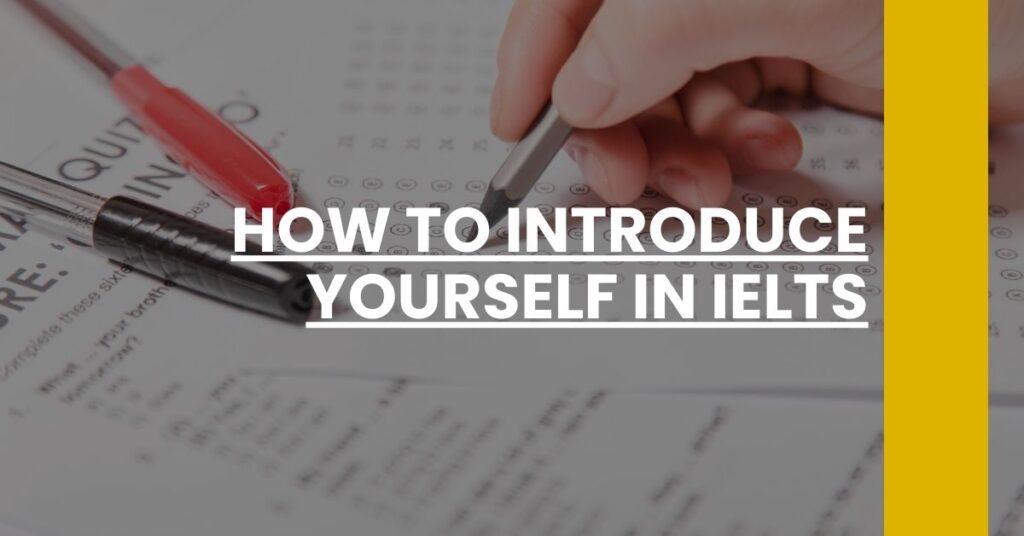Learn how to introduce yourself in IELTS with ease and confidence.
- IELTS Speaking Introduction Tips: Essential strategies for a strong first impression.
- Avoid Common Mistakes: Navigate the pitfalls of self-introduction in your IELTS exam.
- Practice Techniques: Sharpen your introduction with effective practice methods.
Master the art of how to introduce yourself in IELTS today.
- Understanding the IELTS Speaking Section
- Crafting a Compelling Introduction
- Common Introduction Mistakes to Avoid
- Elements of a Strong IELTS Introduction
- Personalizing Your Introduction
- Practice Makes Perfect
- Sample IELTS Introductions and Analysis
- Adjusting Your Introduction for Different Prompts
- Feedback and Continual Improvement
- Conclusion: The Lasting Impression
Understanding the IELTS Speaking Section
When it comes to the IELTS Speaking test, you have a prime opportunity to make an outstanding first impression, and it all begins with how you introduce yourself. This section is an oral interview between you and an examiner, and it’s designed to assess your spoken English skills, not just your ability to regurgitate scripted answers.
The Three Parts Overview
The IELTS Speaking section is neatly sliced into three parts:
- Part 1: Here, you’ll chat with the examiner about familiar topics such as your hobbies, work, or studies.
- Part 2: You’ll receive a card with a topic and take a minute to gather your thoughts before speaking on the subject for two minutes.
- Part 3: The last part takes a deeper dive, as the examiner asks you more abstract questions based on the theme from Part 2.
Your introduction falls under Part 1, setting the scene for a smooth conversation flow for the remaining parts. Use this moment strategically—it’s your golden minute to showcase your clarity, fluency, and personality in English.
Crafting a Compelling Introduction
When considering how to introduce yourself in IELTS, it’s essential to thread the needle between informative and concise. Here’s how to tailor your introduction to resonate with your examiners:
Focus on Key Personal Details
- First key idea: Kickoff with your name. It might seem obvious, but it’s your identity’s calling card.
- Second key idea: Briefly touch upon where you’re from, possibly sharing a notable detail about your city or country that can spark interest.
- Third key idea: Mention your current situation, whether you’re a student, professional, or something in-between, focusing on why you’re taking the IELTS.
Remember, clarity is your ally. If you burrow into too many details or overcomplicate your language, you could trip up on your words or eat into precious test time. Stick to succinct, confident responses.
Common Introduction Mistakes to Avoid
Stumbling in your introduction can be a minefield that sets the wrong tone. So what should you steer clear of?
Overthinking Your Response
Considered preparation is important, but don’t concoct a Shakespearean monologue. Keep it natural, and stay flexible—scripted responses can sound robotic. And remember, speed is not your friend here. Speaking at a pace that allows for clear enunciation is a secret weapon in creating impact with your introduction.
Elements of a Strong IELTS Introduction
So, what makes an introduction shine? Think of your introduction as a mini-presentation about yourself. Here are the essentials:
Convey Confidence and Clarity
- Name and Background: “Good morning, my name is…” sets you off on the right foot. Follow with a dash of background info.
- Reason for Taking IELTS: “I’m here because…” provides a clear motive for your exam, showing goal orientation.
- Balanced Language: Using neither unduly simple nor overly complex language demonstrates range without risking confusion.
Each component weaves together a tapestry of who you are, creating a clear and concise picture for the examiner.
Personalizing Your Introduction
In the IELTS Speaking section, personalization is the spark that ignites engagement—you’re not just another test number. Here’s how to infuse your personality into your introduction:
Share with Authenticity
Draw on your personal experiences to give life to your introduction. Talk about a hobby you’re passionate about or a dream that drives you. When you connect emotionally with your subject matter, your sincerity won’t go unnoticed. A personal storytelling technique can transform a standard introduction into something memorable.
Be you, because everyone else is taken. Approach your introduction with a blend of preparation and genuine self-reflection. It’s about presenting the real you, the you that will continue to converse, argue and engage throughout the rest of the test.
Practice Makes Perfect
Perfecting how to introduce yourself in IELTS is akin to preparing for a pivotal performance: the more you rehearse, the more natural it will become. Seasoned musicians don’t simply learn their chords; they practice until their fingers move effortlessly. Similarly, you should practice your self-introduction to the point where it feels like a comfortable conversation starter, not a rigid script.
Establish a Routine
- Daily Dedication: Set aside time every day to practice your speaking skills. Just like a gym routine builds muscle, consistent practice strengthens your linguistic abilities.
- Record and Review: Use a voice recorder to capture your introduction. Listening back will highlight areas for improvement that you might miss in the moment.
- Training Tools: Leverage language learning apps or websites. They can simulate the IELTS speaking environment, providing a space for low-pressure practice.
Embrace Constructive Criticism
Engage with peers or tutors who can provide you with feedback. What you perceive as strengths in your delivery might actually be areas needing refinement. Having another pair of ears can be invaluable, as they may notice quirks in your pronunciation that you’ve grown accustomed to.
Remember, practice isn’t just about repetition—it’s about mindful repetition with a focus on continuous improvement.
Sample IELTS Introductions and Analysis
To better understand how to introduce yourself in IELTS, let’s dissect a few examples:
Introduction A
Sample Response: “Good morning! My name is Jane, and I hail from the buzzing metropolitan city of Kuala Lumpur. As a recent graduate in Environmental Science, I am eager to pursue a Master’s program abroad, which is why I’m taking the IELTS.”
Analysis:
- Simplicity: Jane keeps it simple. No jargon, just clarity.
- Contextual Detail: Mentioning her city offers a glimpse into her background.
- Purpose: Jane concisely states her reason for taking the test, keeping the focus sharp.
Introduction B
Sample Response: “Hello, I’m called Alex. I live in Brazil, the land of soccer and samba. Although I am an accountant by profession, my passion for language and travel has brought me here to sit for this exam.”
Analysis:
- Personality: Alex injects his passions into the introduction, giving it colour.
- Career vs. Aspiration: He draws a line between his current career and his aspirations, which suggests multifaceted interests.
By assessing these introductory responses, we can extract valuable lessons on what makes an introduction engaging and effective for the IELTS Speaking section.
Adjusting Your Introduction for Different Prompts
IELTS Speaking Part 1 could lead you down several conversational avenues. Your introduction should be adaptable, something you can tweak to smoothly segue into various prompts.
Personalize on the Fly
- Home Life: “I’ve grown up in a quaint countryside town…” This segues into questions about your hometown or living situation.
- Work or Studies: “As someone studying international business…” sets the stage for discussions related to your field of expertise or education.
- Leisure Activities: “On weekends, I enjoy…” provides a springboard into your hobbies or interests.
Craft your core introduction in such a way that it can be easily modified to roll with the different prompts you might encounter during the test.
Feedback and Continual Improvement
IELTS success isn’t a finished mural but rather a canvas that continually evolves through feedback. Find opportunities to gather input on your speech:
From Whom to Seek Feedback
- Language Tutors: They can critique with a professional eye.
- IELTS Practice Groups: Engage with peers who are also preparing for the test. Peer-to-peer learning can be highly beneficial.
Utilize resources like IELTS Progress Check, where official IELTS markers offer ratings, to elevate your introduction.
Conclusion: The Lasting Impression
In closing, mastering how to introduce yourself in IELTS crystallizes into a blend of preparation, personalization, and practice. It’s about building a muscle memory of fluency and confidence that lets you begin your Speaking test on the right note.
As you refine your introduction, remember that it’s not about impressing with verbosity or complexity—it’s about imparting a snapshot of who you are with the poise and ease that comes from being well-prepared. In the grand scheme of your IELTS journey, a powerful introduction is a step that paves the path to a score that truly reflects your language mastery. So, practice diligently, polish relentlessly, and when test day comes, speak with the confidence of someone who’s ready to conquer conversation.
Learn how to introduce yourself in IELTS with effective strategies for a confident and memorable first impression in your exam.

